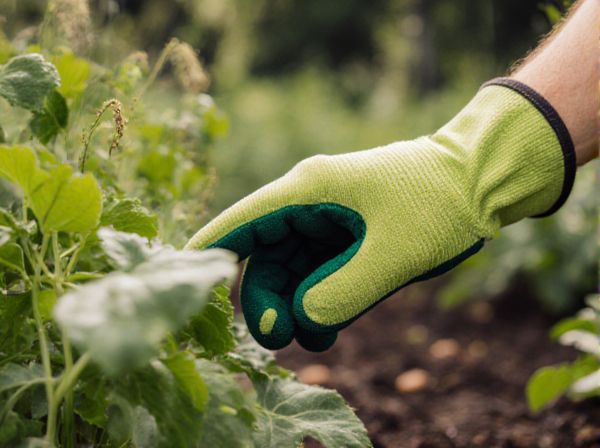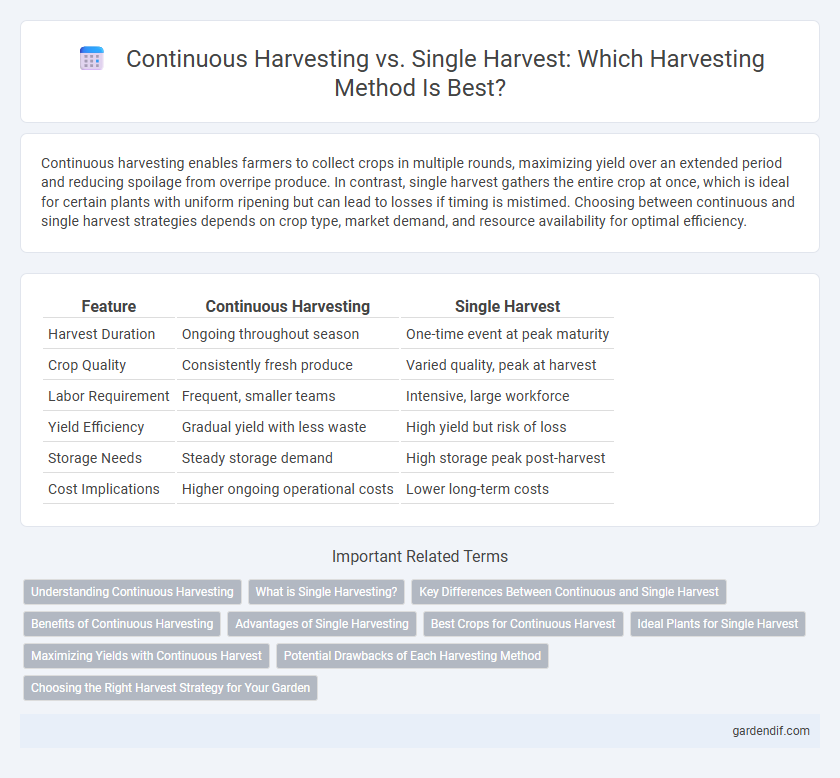
Continuous Harvesting vs Single Harvest Illustration
Continuous harvesting enables farmers to collect crops in multiple rounds, maximizing yield over an extended period and reducing spoilage from overripe produce. In contrast, single harvest gathers the entire crop at once, which is ideal for certain plants with uniform ripening but can lead to losses if timing is mistimed. Choosing between continuous and single harvest strategies depends on crop type, market demand, and resource availability for optimal efficiency.
Table of Comparison
| Feature | Continuous Harvesting | Single Harvest |
|---|---|---|
| Harvest Duration | Ongoing throughout season | One-time event at peak maturity |
| Crop Quality | Consistently fresh produce | Varied quality, peak at harvest |
| Labor Requirement | Frequent, smaller teams | Intensive, large workforce |
| Yield Efficiency | Gradual yield with less waste | High yield but risk of loss |
| Storage Needs | Steady storage demand | High storage peak post-harvest |
| Cost Implications | Higher ongoing operational costs | Lower long-term costs |
Understanding Continuous Harvesting
Continuous harvesting involves regularly collecting crops over an extended period, maximizing yield by harvesting only mature produce while allowing younger plants to grow. This method increases overall productivity and reduces waste compared to single harvest, which involves gathering all crops at once, often leading to overripe or unharvested produce. Understanding continuous harvesting enables farmers to optimize plant growth cycles, improve resource efficiency, and meet market demands with fresh, high-quality produce consistently.
What is Single Harvesting?
Single harvesting refers to collecting all mature crops or produce from a field or plant at one specific time, ensuring uniformity in quality and ease of processing. This method is commonly used for crops like wheat, rice, and corn, where the entire crop ripens simultaneously. Single harvesting optimizes labor and machinery use but may risk losses if adverse weather occurs before collection.
Key Differences Between Continuous and Single Harvest
Continuous harvesting involves regularly collecting crops multiple times throughout the growing season, maximizing yield and reducing waste. Single harvest occurs when all mature crops are gathered at once, simplifying labor but potentially increasing spoilage risk. Continuous harvesting supports fresher produce availability, while single harvest suits crops with synchronized maturity.
Benefits of Continuous Harvesting
Continuous harvesting maximizes yield by allowing multiple harvests throughout the growing season, ensuring a steady supply of fresh produce. This method reduces crop waste and optimizes resource use, such as water and nutrients, leading to improved overall efficiency. Farmers benefit from increased market opportunities and enhanced soil health due to consistent crop rotation and minimal soil disruption.
Advantages of Single Harvesting
Single harvesting ensures uniform crop maturity, facilitating efficient processing and higher quality control. This method reduces labor costs by concentrating efforts into a single operation, optimizing resource allocation. Moreover, single harvest minimizes the risk of crop loss due to weather fluctuations or pest infestations during extended harvest periods.
Best Crops for Continuous Harvest
Continuous harvesting is ideal for crops like lettuce, spinach, kale, and strawberries, which produce new leaves or fruits regularly and can be picked multiple times throughout their growing season. These crops benefit from staggered planting and regular harvesting, maximizing yield and extending the productivity period. Single-harvest crops such as tomatoes or pumpkins focus all energy into one fruiting event, making them less suitable for continuous harvesting strategies.
Ideal Plants for Single Harvest
Ideal plants for single harvest include root vegetables like carrots and beets, as well as fruits such as tomatoes and pumpkins that mature simultaneously. These crops benefit from a one-time, large-scale collection, maximizing yield at peak ripeness and reducing labor costs. Single harvest plants generally have uniform growth cycles, making them well-suited for efficient agricultural planning and market timing.
Maximizing Yields with Continuous Harvest
Continuous harvesting techniques significantly enhance crop yields by allowing multiple harvests throughout the growing season, thereby maximizing productivity per unit area. Unlike single harvest systems that collect all produce at once, continuous harvesting ensures fresh produce is gathered regularly, reducing waste and maintaining peak quality. This method optimizes both resource utilization and market supply, increasing profitability for farmers.
Potential Drawbacks of Each Harvesting Method
Continuous harvesting can lead to inconsistent fruit quality and increased labor costs due to the need for frequent picking cycles. Single harvest methods risk overripe or damaged crops if the timing is misjudged, potentially decreasing overall yield and market value. Both approaches require careful management to balance resource allocation and crop preservation effectively.
Choosing the Right Harvest Strategy for Your Garden
Continuous harvesting maximizes yield by allowing multiple picking cycles, ideal for fast-growing crops like lettuce and herbs that produce over extended periods. Single harvest suits root vegetables and grains, where crops mature fully at once, simplifying labor and timing. Selecting the right strategy depends on crop type, garden size, and desired harvest frequency to optimize productivity and resource use.
Continuous Harvesting vs Single Harvest Infographic

 gardendif.com
gardendif.com